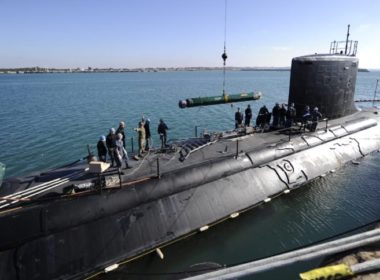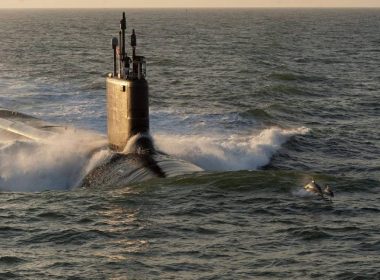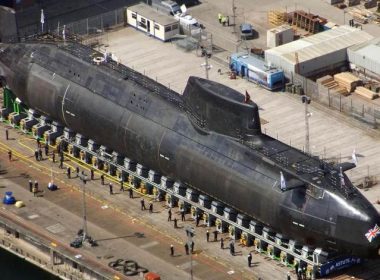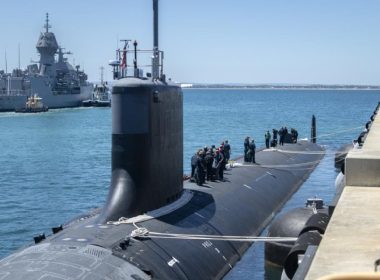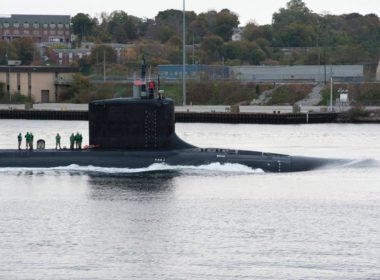OPINION | SSN AUKUS is at the back of the queue

The SSN AUKUS “optimal pathway” calls for the UK to build the first of the nuclear-powered and conventionally-armed attack submarines at Barrow in Furness, starting as early as the late 2020s.
The submarine is expected to be operational as early as the late 2030s—approximately 10 years to build and commission. How realistic is the UK component of this plan?
In my earlier Strategist article, I flagged the impact of years of underinvestment, long delays in maintenance, extended patrols to sustain the continuous at sea deterrent, and poor morale leading to personnel shortages in the Royal Navy’s submarine capability. This underinvestment has also impacted shore infrastructure, with an SSN and a SSBN ballistic missile submarine reportedly awaiting a certified dock since early last year.
In terms of submarine numbers, manpower and shore infrastructure, recovery will not be simple or quick. A recent analysis of the UK’s Defence planned equipment acquisition over the next decade identifies a worst case £29.8 billion or 10 per cent shortfall in the budget, supporting the conclusion that it is “unaffordable, with over spends on its nuclear program now clearly responsible for the overall insolvency of the plan”.
“There have been no indications that Australia is actively involved in this process, or plans to mandate an Australian supply chain.”
The UK Submarine Delivery Agency’s 2022-23 annual report is a masterpiece in reassuring corporate reporting, without providing any explanation of what is being done to overcome the shortcomings noted above, or any precise target dates for the completion of new Astute SSN or Dreadnought SSBN boats. So, we are forced to make some estimates.
Each of the last three Astute-class now in commission (HMS Artful, Audacious, Anson) has taken 130 to 132 months to build. Two submarines remain under construction. HMS Agamemnon is expected to commission in mid-2024 after a 130-month build and HMS Agincourt is expected to commission in mid-2026 after a 99-month build. The shortened build time for the last Astute is presumably intended to make room for SSN AUKUS?
The 130-month build time may well be a result of funding restrictions, not yard capacity, but it sets the workforce capability, so 99 months is still a huge step up for the workforce and facilities. Ninety-nine months to build and commission Agincourt would be 31 months shorter than the previous four submarines in the class and 13 months faster that BAE Systems has ever built an Astute. The risk of delays from completion of the final Astute is significant, with ramifications for the start of SSN AUKUS.
The challenge for BAES in completing the Astute build and starting the SSN AUKUS build is compounded by other, higher priority work in the yard: construction of four Dreadnought-class ballistic missile submarines. These are urgently required to relieve the elderly and increasingly unreliable Vanguard-class, which are struggling to sustain the continuous at-sea deterrent. Three Dreadnoughts, a large, 17,200-tonne submarine (more than twice the size of Astute), are currently under construction. The UK Ministry of Defence advises that the program is on track and the first is due to enter service in the “early 2030s”.
All does not seem well, however. In March 2023, £2 billion of the £10 billion contingency fund allocated for the project was committed “to bring construction forward”. Committing 20 per cent of the project’s contingent funding part way through the construction of the first submarine is most unusual. In the absence of an improved completion target announcement, I assume that the early 2030s remains the target? So, it would seem likely that the contingency has been committed to top up an inadequate original budget or to recover from difficulties, in order to maintain the early 2030s completion date.
Construction of the next two SSBNs started in 2019 and 2023, with the fourth yet to commence. Allowing for (an optimistic) 12 years to build each submarine, the final boat will not be completed before the mid to late 2030s.
The first UK SSN AUKUS build, starting in the late 2020s and aiming for an operational date in the late 2030s, is therefore in a queue, behind the higher priority Dreadnought and Astute programs.
The design process for SSN AUKUS does not seem to be in any better shape. Although the UK MOD has issued a £3.95 billion contract to BAES for the detailed design, there are reports that BAES is seeking significant help from design staff at the US builder, General Dynamics Electric Boat, to assist in this process, possibly requiring additional funding? There have been no indications that Australia is actively involved in this process, or plans to mandate an Australian supply chain as I have argued for earlier.
“Whilst the US shipbuilding industry has no spare capacity to build additional SSNs for Australia, it is in a far healthier state than the UK’s.”
Given this situation, I suggest that the UK’s SSN AUKUS 01 design and build is highly likely to be later than planned.
Even if it proceeds to plan, Australia is unlikely to benefit from the lessons learnt in the UK’s construction of the first SSN AUKUS, as the first build in Australia is planned on a similar timescale. Construction of the RAN’s first SSN AUKUS in Australia is intended to start in the late 2020s, taking longer to build, achieving an operational submarine in the early 2040s.
In my recent article, I argued that shifting the SSN AUKUS design baseline to the US-designed Virginia-class SSN would reduce risks, cost, and the time to acquire SSN AUKUS.
Whilst the US shipbuilding industry has no spare capacity to build additional SSNs for Australia, it is in a far healthier state than the UK’s. The most recent three of the 22 Virginia class submarines commissioned in an average of 59 months, less than half the Astute build time.
Shifting to a Virginia baseline for SSN AUKUS would avoid the shortcomings and risks arising from the UK situation. It would avoid the problems of a UK-based supply chain for a small number of submarines and trying to build an unproven design. Virginia provides a highly refined and proven design baseline, with the possibility of a much shorter construction time. Australia will be operating one of many Virginia-class submarines in the Indo-Pacific. In addition to these advantages, it may be able to avoid or reduce the need to purchase Virginia-class submarines from the USN’s current inventory, an increasingly problematic concept.
A Virginia baseline for SSN AUKUS would also relieve the UK of the need to lead the design, freeing up resources to reconstitute its submarine capability and complete the Dreadnought and Astute programs.
The answer to my question in the opening paragraph is that the UK components of the plan are hostage to several pre-existing and higher priority risks, and success is unlikely.
It is time for a change of direction before the three countries waste more time and resources on a plan that is not going to work.


